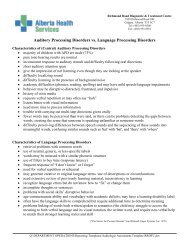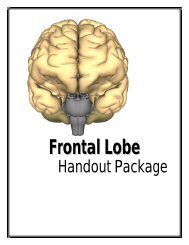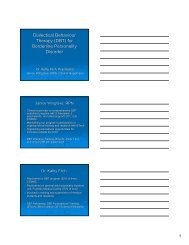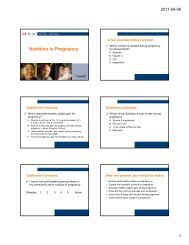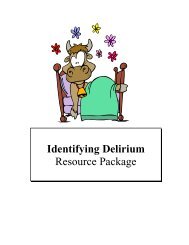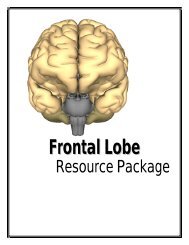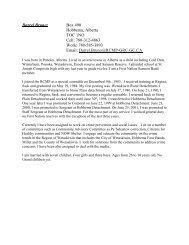Dominant and Submissive Interpersonal Styles in ... - Onehealth.ca
Dominant and Submissive Interpersonal Styles in ... - Onehealth.ca
Dominant and Submissive Interpersonal Styles in ... - Onehealth.ca
Create successful ePaper yourself
Turn your PDF publications into a flip-book with our unique Google optimized e-Paper software.
<strong>Dom<strong>in</strong>ant</strong> <strong>and</strong> <strong>Submissive</strong><br />
<strong>Interpersonal</strong> <strong>Styles</strong> <strong>in</strong> Men<br />
Who Use Violence:<br />
Impli<strong>ca</strong>tions for Treatment?<br />
Dr. Lisa Buys, Ph.D<br />
Danielle Tessier<br />
The Duluth Model<br />
All men who use violence are<br />
batterers<br />
A batterer systemati<strong>ca</strong>lly uses<br />
violence <strong>and</strong> other forms of abuse to<br />
ma<strong>in</strong>ta<strong>in</strong> power <strong>and</strong> control <strong>in</strong> an<br />
<strong>in</strong>timate relationship<br />
Involves dom<strong>in</strong>ant behaviors <strong>and</strong><br />
patriarchal beliefs<br />
2<br />
Power <strong>and</strong> Control Wheel<br />
3
Where are all the batterers?<br />
The view that all men who have used<br />
violence are dom<strong>in</strong>ant batterers<br />
conflicts with cl<strong>in</strong>i<strong>ca</strong>l experience<br />
Differences between behavior <strong>in</strong><br />
group <strong>and</strong> behavior <strong>in</strong> the home?<br />
Are most ‘batterers’ serv<strong>in</strong>g time?<br />
4<br />
Heterogeneity among men who<br />
have been violent<br />
Heterogeniety <strong>in</strong> men who use<br />
violence has been well established <strong>in</strong><br />
the research literature<br />
A number of typologies have<br />
emerged to describe key differences<br />
These differences have not yet had a<br />
signifi<strong>ca</strong>nt effect on treatment<br />
programs<br />
5<br />
Holtzworth-Munroe <strong>and</strong> Stuart<br />
Comprehensive review of 15 exist<strong>in</strong>g<br />
articles on typologies of spousal<br />
abusers (up to 1994)<br />
Categorized along 3 dimensions :<br />
1. Severity <strong>and</strong> frequency of violence<br />
2. Generality of violence<br />
3. Psychopathology or personality<br />
disorder<br />
6
Family-only<br />
Engage <strong>in</strong> the least marital violence <strong>and</strong><br />
extrafamilial violence<br />
Little or no sign of psychopathology<br />
Violence stems from stress <strong>and</strong> low-level<br />
risk factors (childhood exposure to marital<br />
violence, poor relationship skills)<br />
Absence of psychopathology would help<br />
prevent es<strong>ca</strong>lation of violence through<br />
feel<strong>in</strong>gs of remorse.<br />
7<br />
Borderl<strong>in</strong>e/Dysphoric<br />
Engage <strong>in</strong> moderate to severe spousal<br />
abuse <strong>and</strong> may perpetrate some<br />
extrafamilial violence<br />
Show the most psychologi<strong>ca</strong>l distress <strong>and</strong><br />
borderl<strong>in</strong>e personality characteristics<br />
Victims of parental abuse <strong>and</strong> rejection,<br />
result<strong>in</strong>g <strong>in</strong> <strong>in</strong>secure attachment (trust<br />
issues, highly dependant yet fearful of<br />
loos<strong>in</strong>g wives, high levels of jealousy)<br />
High levels of impulsivity<br />
Deficits <strong>in</strong> marital communi<strong>ca</strong>tion skills 8<br />
Generally violent/Antisocial<br />
Engage <strong>in</strong> moderate to severe marital<br />
violence <strong>and</strong> the highest level of violence<br />
outside the home<br />
Most likely to show evidence of antisocial<br />
personality disorder<br />
High level risk factors (hostility toward<br />
women, positive attitudes toward violence,<br />
association with deviant peers)<br />
Impulsivity <strong>and</strong> deficit <strong>in</strong> general social<br />
skills<br />
Spousal abuse hypothesized to be side<br />
component to general use of violence,<br />
aggression <strong>and</strong> antisocial behavior<br />
9
Dutton Typology<br />
Three subtypes:<br />
Cycli<strong>ca</strong>l<br />
Psychopathic<br />
Overcontrolled<br />
10<br />
Cycli<strong>ca</strong>l batterer<br />
Borderl<strong>in</strong>e personality– extreme<br />
need to control <strong>in</strong>timacy, prone to<br />
rage <strong>and</strong> jealousy<br />
“Jeckyl <strong>and</strong> Hyde” – cycle of abuse<br />
Fearful attachment style<br />
50% of men who use violence<br />
11<br />
Psychopathic batterer<br />
Antisocial personality<br />
Violent outside the home, More<br />
nonviolent crim<strong>in</strong>al behavior<br />
Dismissive attachment style<br />
20% of men who use violence<br />
12
Overcontrolled batterer<br />
Distanced from own feel<strong>in</strong>gs,<br />
avoidant, passive-aggressive<br />
Violence results from buildup of<br />
stress, anger or other negative<br />
emotions<br />
Preoccupied attachment style<br />
30% of men who use violence<br />
13<br />
Gottman<br />
Studied men who have used severe<br />
violence<br />
Exam<strong>in</strong>ed heart rates at rest <strong>and</strong><br />
dur<strong>in</strong>g conflict<br />
Cobra group – heart rate decrease<br />
dur<strong>in</strong>g conflict (20%)<br />
Pitbull group – heart rate <strong>in</strong>crease<br />
dur<strong>in</strong>g conflict (80%)<br />
14<br />
Comparison of Typologies<br />
Holzworth- Dutton<br />
Gottman<br />
Munroe<br />
Generally Psychopathic Cobra<br />
violent<br />
Borderl<strong>in</strong>e Cycli<strong>ca</strong>l Pitbull<br />
Family Only Over-controlled Pitbull<br />
15
Problems<br />
Antisocial <strong>and</strong> borderl<strong>in</strong>e types make<br />
sense theoreti<strong>ca</strong>lly<br />
Can f<strong>in</strong>d clear (sometimes extreme)<br />
<strong>ca</strong>ses that fit the <strong>ca</strong>tegory, but <strong>in</strong><br />
reality antisocial <strong>and</strong> borderl<strong>in</strong>e<br />
personality traits often overlap<br />
Useful <strong>in</strong> risk assessment, but limited<br />
utility <strong>in</strong> treatment<br />
16<br />
Problems (Cont’d)<br />
Third subtype is poorly def<strong>in</strong>ed– a<br />
default <strong>ca</strong>tegory for men without<br />
extreme personality pathology???<br />
Most men <strong>in</strong> our groups would fall<br />
<strong>in</strong>to this third <strong>ca</strong>tegory<br />
17<br />
Problems (Cont’d)<br />
Proportion of men fall<strong>in</strong>g <strong>in</strong>to<br />
<strong>ca</strong>tegories depends on sample be<strong>in</strong>g<br />
exam<strong>in</strong>ed – community, cl<strong>in</strong>i<strong>ca</strong>l,<br />
forensic<br />
18
Tweed <strong>and</strong> Dutton (1998)<br />
Studied two recurrently identified<br />
subtypes: Impulsive <strong>and</strong> Instrumental<br />
Impulsive – withdrawn, moody <strong>in</strong>dividuals<br />
hypersensitive to perceived slights,<br />
volatile, over-reactive, most<br />
psychologi<strong>ca</strong>lly abusive<br />
Instrumental – narcissistic entitlement,<br />
psychopathic manipulativeness, childhood<br />
victims of severe violence, violent outside<br />
the home<br />
19<br />
Instrumental <strong>and</strong> Impulsive<br />
Impulsive or Reactive??<br />
Def<strong>in</strong><strong>in</strong>g behavior or <strong>in</strong>dividuals???<br />
Although some clients show a clear<br />
propensity for <strong>in</strong>strumental or<br />
impulsive violence, most clients use<br />
both<br />
Most violent behavior is both<br />
<strong>in</strong>strumental <strong>and</strong> reactive<br />
20<br />
Johnson typology<br />
Categorizes men who use violence<br />
on the basis of the relationship<br />
context of the violence<br />
Common couple violence<br />
Intimate terrorism – batterer?<br />
Violent resistance<br />
Mutual violent control<br />
21
What is Controll<strong>in</strong>g Behavior?<br />
Form vs. function<br />
E.g., giv<strong>in</strong>g an order is a dom<strong>in</strong>ant<br />
behavior, but it is only controll<strong>in</strong>g if it<br />
affects the behavior of another<br />
person<br />
Men may be more likely than women<br />
to use physi<strong>ca</strong>l fear to control<br />
Are women more likely to use other<br />
types of behavior to control?? 22<br />
A different approach<br />
Are there other ways to classify men who<br />
use violence?<br />
- provide a better fit with cl<strong>in</strong>i<strong>ca</strong>l<br />
experience<br />
- be more useful <strong>in</strong> develop<strong>in</strong>g treatment<br />
approaches<br />
23<br />
<strong>Dom<strong>in</strong>ant</strong> vs. <strong>Submissive</strong><br />
<strong>Interpersonal</strong> Style<br />
<strong>Dom<strong>in</strong>ant</strong> – Show more dom<strong>in</strong>ant<br />
behavior <strong>in</strong> group <strong>and</strong> report more<br />
dom<strong>in</strong>ant behaviors towards<br />
partners, more abusive attitudes,<br />
<strong>Submissive</strong> – Show more passive<br />
behavior <strong>in</strong> group <strong>and</strong> report more<br />
passive relationship behavior,<br />
struggle with assertion, fewer<br />
abusive attitudes<br />
24
<strong>Interpersonal</strong> style<br />
An <strong>in</strong>terpersonal style is an <strong>in</strong>dividual’s<br />
characteristic way of <strong>in</strong>teract<strong>in</strong>g with<br />
others.<br />
Focus on behavior<br />
Extensive research on <strong>ca</strong>tegoriz<strong>in</strong>g<br />
<strong>in</strong>terpersonal style<br />
Violence is always a dom<strong>in</strong>ant act, but it<br />
may or may not be consistent with an<br />
<strong>in</strong>dividual’s typi<strong>ca</strong>l <strong>in</strong>terpersonal style<br />
25<br />
<strong>Interpersonal</strong> style Contd.<br />
These groups may show characteristic<br />
differences relat<strong>in</strong>g to their offence, risk of<br />
re-offend<strong>in</strong>g <strong>and</strong> treatment needs.<br />
Spousal abusers with a submissive<br />
<strong>in</strong>terpersonal style, <strong>in</strong> contrast to a<br />
dom<strong>in</strong>ant <strong>in</strong>terpersonal style, may be<br />
more likely be passive <strong>in</strong> their<br />
relationships, r<strong>and</strong>omly violent rather than<br />
regularly violent, <strong>and</strong> have alcohol as a<br />
factor <strong>in</strong> their offence.<br />
26<br />
<strong>Interpersonal</strong> Circle<br />
27
Measur<strong>in</strong>g <strong>Interpersonal</strong> Style<br />
Personality Assessment Inventory<br />
(PAI)<br />
Assesses a broad range of<br />
symptoms, pathologi<strong>ca</strong>l personality<br />
tendencies <strong>and</strong> other problem areas<br />
Includes two s<strong>ca</strong>les measur<strong>in</strong>g<br />
<strong>in</strong>terpersonal style (Dom<strong>in</strong>ance <strong>and</strong><br />
Warmth)<br />
28<br />
Dom<strong>in</strong>ance S<strong>ca</strong>le<br />
Very High Dom<strong>in</strong>ance –<br />
Dom<strong>in</strong>eer<strong>in</strong>g, overcontroll<strong>in</strong>g, strong<br />
needs to control others, driven to<br />
appear competent <strong>and</strong> authoritative,<br />
with little tolerance for those who<br />
disagree with their plans <strong>and</strong> desires<br />
Very Low Dom<strong>in</strong>ance – self-effac<strong>in</strong>g,<br />
subord<strong>in</strong>ate their <strong>in</strong>terests to those<br />
of others, vulnerable to mistreatment<br />
<strong>and</strong> exploitation<br />
29<br />
Warmth S<strong>ca</strong>le<br />
Very High Warmth – strong needs to<br />
be accepted by others, too <strong>ca</strong>r<strong>in</strong>g<br />
<strong>and</strong> trust<strong>in</strong>g, avoids all conflict <strong>and</strong><br />
the expression of anger<br />
Very Low Warmth – cold, unfeel<strong>in</strong>g,<br />
unable to display affection or make<br />
commitment to personal<br />
relationships<br />
30
Inventory of <strong>Interpersonal</strong><br />
Problems (IIP)<br />
Assesses the k<strong>in</strong>ds of problems an<br />
<strong>in</strong>dividual experiences <strong>in</strong> his (or her)<br />
relationships<br />
Self-report<br />
Example – “It is hard for me to tell a<br />
person to stop bother<strong>in</strong>g me”<br />
Results <strong>ca</strong>n be profiled on the<br />
<strong>in</strong>terpersonal circle<br />
31<br />
Case 1: Dan<br />
33 year old man<br />
Pushed her after she confronted him<br />
about his <strong>in</strong>fidelity<br />
M<strong>in</strong>imized offence<br />
History of violence <strong>in</strong> relationship<br />
History of violence outside<br />
relationship<br />
Substance abuse problem, antisocial<br />
personality traits<br />
32<br />
Dan (Cont’d)<br />
IIP – <strong>Dom<strong>in</strong>ant</strong> <strong>in</strong>terpersonal style<br />
PAI – Very high Dom<strong>in</strong>ance, Low<br />
Warm<br />
Psychopathic or Antisocial Type<br />
33
Case 2: Bob<br />
38 years old, punched victim <strong>in</strong> jaw<br />
States he was react<strong>in</strong>g to her<br />
aggressive behavior<br />
No crim<strong>in</strong>al history, but prior<br />
violence <strong>in</strong> relationship<br />
Substance abuse not a factor<br />
Remorseful <strong>and</strong> ashamed of his<br />
violent behavior<br />
34<br />
Bob (Cont’d)<br />
IIP – Peak on nonassertive, socially<br />
<strong>in</strong>hibited<br />
PAI – Average on dom<strong>in</strong>ance <strong>and</strong><br />
warmth<br />
Family only???<br />
35<br />
Case 3: Joe<br />
27 year-old who hit victim <strong>in</strong> head with<br />
a shoe, highly <strong>in</strong>toxi<strong>ca</strong>ted<br />
Both he <strong>and</strong> partner had alcohol<br />
problems<br />
History of frequent conflicts, he has<br />
been physi<strong>ca</strong>lly assaultive <strong>in</strong> past<br />
Witness to parental violence as a child<br />
One prior property offence – no<br />
violence<br />
36
Joe (Cont’d)<br />
PAI – Average DOM, average WRM<br />
IIP – Peak on “overly<br />
accommodat<strong>in</strong>g”<br />
37<br />
Problems with Self-report<br />
measurement<br />
38<br />
Next Steps <strong>and</strong> Resarch<br />
Impli<strong>ca</strong>tions<br />
Don’t throw the baby out with the<br />
bathwater<br />
39
Questions/Discussion<br />
40<br />
Thank you for your participation<br />
For <strong>in</strong>formation about Telemental<br />
Health edu<strong>ca</strong>tion sessions:<br />
(403) 783-7736<br />
www.amhb.ab.<strong>ca</strong><br />
–Initiatives<br />
– Telemental Health<br />
– Current Telelearn<strong>in</strong>g Sessions<br />
41





